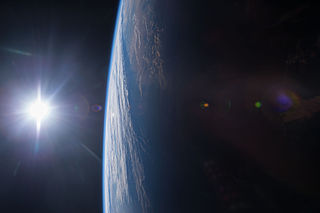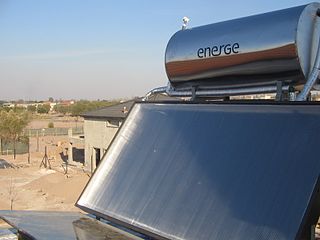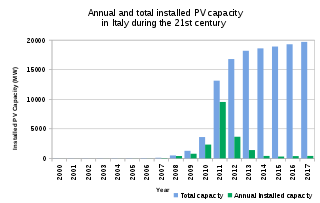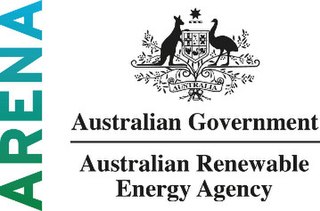
Solar energy is the radiant energy from the Sun's light and heat, which can be harnessed using a range of technologies such as solar electricity, solar thermal energy and solar architecture. It is an essential source of renewable energy, and its technologies are broadly characterized as either passive solar or active solar depending on how they capture and distribute solar energy or convert it into solar power. Active solar techniques include the use of photovoltaic systems, concentrated solar power, and solar water heating to harness the energy. Passive solar techniques include designing a building for better daylighting, selecting materials with favorable thermal mass or light-dispersing properties, and organize spaces that naturally circulate air.

Solar thermal energy (STE) is a form of energy and a technology for harnessing solar energy to generate thermal energy for use in industry, and in the residential and commercial sectors. Solar thermal collectors are classified by the United States Energy Information Administration as low-, medium-, or high-temperature collectors. Low-temperature collectors are generally unglazed and used to heat swimming pools or to heat ventilation air. Medium-temperature collectors are also usually flat plates but are used for heating water or air for residential and commercial use.

White Cliffs Solar Power Station was Australia's first solar power station. It is located at White Cliffs, New South Wales, which was chosen as it has the highest insolation in New South Wales, and in 1981 when the station was constructed had no grid connection.

Solar power is a major contributor to electricity supply in Australia. As of December 2023, Australia's over 3.69 million solar PV installations had a combined capacity of 34.2 GW photovoltaic (PV) solar power. In 2019, 59 solar PV projects with a combined capacity of 2,881 MW were either under construction, constructed or due to start construction having reached financial closure. Solar accounted for 12.4% of Australia's total electrical energy production in 2021.

The Mildura Solar Concentrator Power Station was a proposed 100 megawatts (130,000 hp) concentrated photovoltaic (CPV) solar PV system to be built at Carwarp, near Mildura, Victoria, Australia. It was proposed by Solar Systems in 2006, which was acquired by Silex Systems in 2010. A 1.5 MW demonstration plant was completed in April 2013. Construction of the larger facility was expected to commence in 2014 and be completed in 2017. However, the expansion plan was abandoned in August 2014 due to a number of factors, including low wholesale electricity prices, a lack of commitment to clean energy by the Australian government and uncertainty surrounding the Renewable Energy Target (RET) in Australia.

Spain is one of the first countries to deploy large-scale solar photovoltaics, and is the world leader in concentrated solar power (CSP) production.
Solar Systems is an Australian company that has constructed three concentrated solar power stations in remote Indigenous communities the Northern Territory, Australia, using 30 solar concentrator dishes which together generated 720 kilowatts (970 hp) and 1,555,000 kilowatt-hours (5,600,000 MJ) per year. The sites are in Hermannsburg, Yuendumu and Lajamanu. This represents a saving of 420,000 litres of diesel fuel and 1550 tonnes of greenhouse gas emissions.

Renewable energy in Australia is mainly based on biomass, solar, wind, and hydro generation. Over a third of electricity is generated from renewables, and is increasing, with a target to phase out coal power before 2040. Wind energy and rooftop solar have particularly grown since 2010. The growth has been stimulated by government energy policy in order to limit the rate of climate change in Australia that has been brought about by the use of fossil fuels. Pros and cons of various types of renewable energy are being investigated, and more recently there have been trials of green hydrogen and wave power.

Solar power consists of photovoltaics (PV) and solar thermal energy in the European Union (EU).

The Solana Generating Station is a solar power plant near Gila Bend, Arizona, about 70 miles (110 km) southwest of Phoenix. It was completed in 2013. When commissioned, it was the largest parabolic trough plant in the world, and the first U.S. solar plant with molten salt thermal energy storage. Built by the Spanish company Abengoa Solar, the project can produce up to 280 megawatts (MW) gross, supplied by two 140 MW gross (125 MW net) steam turbine generators: enough electricity to meet the needs of approximately 70,000 homes and obviate the emission of roughly 475,000 tons of CO2 every year. Its name is the Spanish term for "sunny spot".

The PS20 solar power plant (PS20) solar power plant is a solar thermal energy plant in Sanlucar la Mayor near Seville in Andalusia, Spain. It was the world's most powerful solar power tower until the Ivanpah Solar Power Facility in California became operational in 2014. The 20 megawatt (MW) solar power tower produces electricity with large movable mirrors called heliostats.

Concentrated solar power systems generate solar power by using mirrors or lenses to concentrate a large area of sunlight into a receiver. Electricity is generated when the concentrated light is converted to heat, which drives a heat engine connected to an electrical power generator or powers a thermochemical reaction.
Wizard Power Pty Ltd was an Australian company headquartered in Canberra, focused on solar technology research, development, and commercialization. One of their notable contributions was the creation of the Big Dish, the world's largest paraboloidal dish solar concentrator.

eSolar is a privately held company that develops concentrating solar power (CSP) plant technology. The company was founded by the Pasadena-based business incubator Idealab in 2007 as a developer of CSP plant technology. The company aims to develop a low cost alternative to fossil fuels through a combination of small heliostats, modular architecture, and a high-precision sun-tracking system. In October 2017, an article in GreenTech Media suggested that eSolar ceased business in late 2016.

David Faiman is a British and Israeli physicist.
Australia is well placed to harness solar thermal energy. Solar thermal energy is used in three main ways: solar hot water heating, production of steam for electricity generation and space heating through building design.

Solar power is an important contributor to electricity generation in Italy, accounting for 11.8% of total generation in 2023, up from 0.6% in 2010 and less than 0.1% in 2000.

The Australian Renewable Energy Agency (ARENA) is an independent agency of the Australian federal government, established in 2012 to manage Australia's renewable energy programs, with the objective of increasing supply and competitiveness of Australian renewable energy sources.














